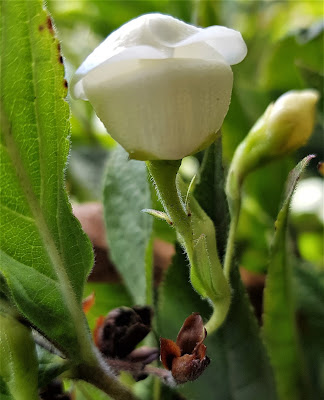Bowkeria and its sticky shell flower no good for oil-prospecting bees
As PlantZAfrica puts it, Bowkeria verticillata is a 'decorative shrub ... with soft quilted leaves and pure white, scented flowers'. But the flowers are not only white and scented, they are also a little icky to touch. According to PlantZAfrica they are 'sticky and glint in the sunshine'. Which they are, and they do.
Natal Shell-flower Bush is one of only three species of Bowkeria, all native to the same part of Africa. Siblings Henry and Elizabeth Bowker were local naturalists of renown in 1859, when the genus was named.
In Melbourne Gardens, Bowkeria verticillata is a messy shrub about 4 metres tall. The flowers, in January, are easily missed. Walking by I noticed what looked like small blobs like bubble gum among the viburnum-like leaves.
On closer inspection the flowers looked like a closed mollusc of some kind. And then I noticed the plant label with its helpful common name, Natal Shell-flower Bush. So these oyster-shaped flowers I was looking at were not abnormal and the plant came from South Africa.
The family on the label was Scrophulariaceae but there have been lots of changes recently in this branch of the Tree of Life, with what used to be a large family now split and redistributed. These days we include Bowkeria in the oddly named family Stilbaceae with 11 other genera, including Stilbe.
In Melbourne Gardens, Bowkeria verticillata is a messy shrub about 4 metres tall. The flowers, in January, are easily missed. Walking by I noticed what looked like small blobs like bubble gum among the viburnum-like leaves.
On closer inspection the flowers looked like a closed mollusc of some kind. And then I noticed the plant label with its helpful common name, Natal Shell-flower Bush. So these oyster-shaped flowers I was looking at were not abnormal and the plant came from South Africa.
The family on the label was Scrophulariaceae but there have been lots of changes recently in this branch of the Tree of Life, with what used to be a large family now split and redistributed. These days we include Bowkeria in the oddly named family Stilbaceae with 11 other genera, including Stilbe.
Contrary to reports, when I rip open a flower it does not exhibit a 'pattern of red marks' on the inside of the scalloped petals, apparently there to guide oil-collecting bees to 'oil hairs' at the centre of the flower. These bees (again according to PlantZAfrica) move the oil from the their front to hind legs and carry it there to feed larvae in the nest.
Along the way I take it they accumulate a little pollen as well, which they distribute between flowers. There doesn't seem to be any pollination advantage to the sticky flowers although I image the surface deters a few unwanted visitors.
In our flowers you can see the four anthers, neatly tucked into the pocket at the base of the flower, and the tubular female receptor (style) in the middle. But no guiding colour bands on the bit pealed away (on some flowers there are faint hints of colour...), and no oil hairs anywhere that I can see. Perhaps they are very small.
The fruit, if it sets without oil hairs and oil-collecting bees, is a 1.5 centimetre long capsule said to look like 'polished cardboard', and remaining on the plant long after it splits to release the tiny seeds. In early February, at the tail end of the flowering, I could find only these woody (cardboardy?) remains of flowers, still quite sticky.
A few of the ovaries looked like they were fertilised, so I tracked the plant through March hoping to find some mature fruit. Sadly, as we arrive at April, nothing to post about.







Comments